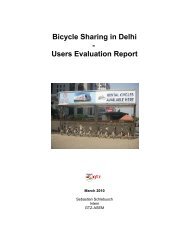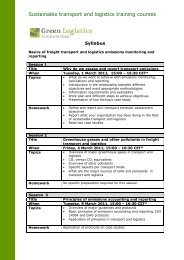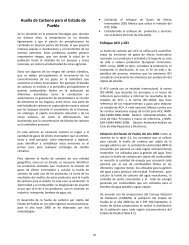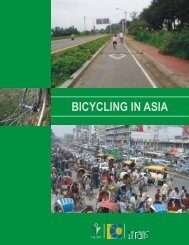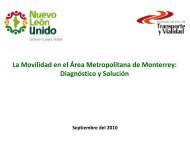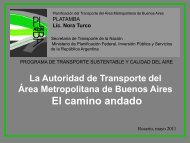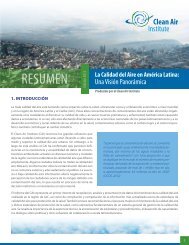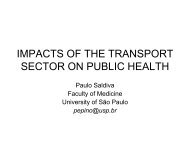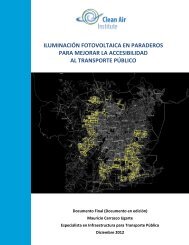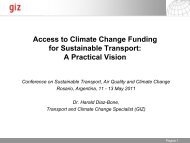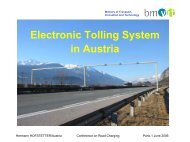Air Quality in Latin America: An Overview - Clean Air Institute
Air Quality in Latin America: An Overview - Clean Air Institute
Air Quality in Latin America: An Overview - Clean Air Institute
Create successful ePaper yourself
Turn your PDF publications into a flip-book with our unique Google optimized e-Paper software.
2012 Edition<strong>Air</strong> <strong>Quality</strong> <strong>in</strong> Lat<strong>in</strong> <strong>America</strong>:<strong>An</strong> <strong>Overview</strong>Produced by the <strong>Clean</strong> <strong>Air</strong> <strong>Institute</strong>
Contents1 Introduction 11.1 Key air pollutant <strong>in</strong>formation 32 Objetives 43 Methodology 53.1 <strong>Air</strong> <strong>Quality</strong> Data Collection 53.2 National <strong>Air</strong> <strong>Quality</strong> Standars 104 Standards and Limit Values 115 <strong>Air</strong> <strong>Quality</strong> Concentrations <strong>in</strong> Lat<strong>in</strong> <strong>America</strong> and the Caribbean 135.1 Particles 145.2 Ozone 165.3 Nitrogen dioxide 185.4 Sulfur dioxide 196 Discussion and Recommendations 206.1 <strong>Air</strong> <strong>Quality</strong> Standards 206.2 <strong>Air</strong> <strong>Quality</strong> monitor<strong>in</strong>g data 216.3 Data analysis 216.4 Recommendations based on this analysis 226.5 Broader recommendations for the region 226.6 F<strong>in</strong>al conclusions 237 References 24<strong>An</strong>nex 1 – Graphical summary of National <strong>Air</strong> <strong>Quality</strong> Standards <strong>in</strong> Lat<strong>in</strong> <strong>America</strong> 25
1. IntroductionIn Lat<strong>in</strong> <strong>America</strong> and the Caribbean (LAC), at least 100 millionpeople are exposed to air pollution above World Health Organization(WHO) recommended levels (Cifuentes et al, 2005). Thegroups most vulnerable to the harmful health effects of poor airquality <strong>in</strong>clude children, the elderly, those with exist<strong>in</strong>g healthconditions and people from lower socioeconomic classes.Figure 1. Number of deaths attributable to air pollution (A) 1 ;Number of years of life lost as a result of premature death fromair pollution (B) 1 ; and Number of deaths as a function of urbanpopulation (C) 3 .Both WHO and the United Nations Environment Program(UNEP) have highlighted outdoor air pollution as one of theirkey strategic focus areas to tackle root causes of death and diseaseglobally. The WHO states <strong>in</strong> a 2011 press release that “For2008, the estimated mortality attributable to outdoor air pollution<strong>in</strong> cities amounts to 1.34 million premature deaths.” Similarly,a report by the Organisation for Economic Co-operationand Development (OECD) (OECD, 2012) which looks forward tothe year 2050 to estimate the impact on the environment if theworld does not adopt more ambitious green policies states:Number of deaths per country2500020000150001000050000Argent<strong>in</strong>aBolivia*Brazil2004 2008ChileColombiaEcuadorMexicoPeruUruguayA* no data for Bolivia <strong>in</strong> 2008“air pollution is set to become the world’s top environmentalcause of premature mortality, overtak<strong>in</strong>g dirtywater and lack of sanitation” with “the number of prematuredeaths from exposure to particulate matter(PM)…projected to more than double worldwide, fromjust over 1 million today to nearly 3.6 million per year<strong>in</strong> 2050”.With<strong>in</strong> its Global Health Observatory data repository, WHO providesaccess to datasets on priority health topics <strong>in</strong>clud<strong>in</strong>g mortalityand burden of diseases . Figure 1 displays data from thisObservatory. Graph A shows the n<strong>in</strong>e Lat<strong>in</strong> <strong>America</strong>n countrieswith the highest numbers of deaths and, as shown <strong>in</strong> Graph C,the countries with the highest death rates <strong>in</strong> 2008 mirror thosewith the highest urban populations. The number of deaths <strong>in</strong>the majority of countries has also seen an <strong>in</strong>crease from 2004to 2008. Graph B shows the number of years of life lost due topremature death from air pollution <strong>in</strong> those countries. The totalfor the n<strong>in</strong>e countries displayed is over 434 million disability lifeyears lost due to premature death from air pollution <strong>in</strong> 2004.Disability -Adusted Life Years2004 ('000)Urban Population 2010 ('000s)20000016000012000080000400001800001600001400001200001000008000060000400002000000Argent<strong>in</strong>aBoliviaBrazilChileColombia0 5000 10000 15000 20000 25000EcuadorMexicoPeruUruguayBCNumber of deaths (2008)1http://www.who.<strong>in</strong>t/mediacentre/news/releases/2011/air_pollution_20110926/en/2Global Health Observatory, http://apps.who.<strong>in</strong>t/ghodata1
The WHO air quality guidel<strong>in</strong>es (AQGs) are <strong>in</strong>tended for worldwideuse and have been developed as guidance to establishnational and/or local air quality standards, support<strong>in</strong>g actionsto achieve air quality that protects public health <strong>in</strong> differentcontexts. The guidel<strong>in</strong>es are updated periodically follow<strong>in</strong>greviews of the latest scientific knowledge and research on thehealth impacts of the pollutants. <strong>Air</strong> quality standards, on theother hand, are set by each country to protect the public healthof their citizens and are usually embedded <strong>in</strong>to law and as suchare an important component of national risk managementand environmental policies. Primary standards provide publichealth protection, <strong>in</strong>clud<strong>in</strong>g protect<strong>in</strong>g the health of “sensitive”populations such as asthmatics, children, and the elderly. Secondarystandards provide public welfare protection, <strong>in</strong>clud<strong>in</strong>gprotection aga<strong>in</strong>st decreased visibility and damage to animals,crops, vegetation, and build<strong>in</strong>gs. National standards will vary bycountry as they will need to balance health risks, technologicalfeasibility, economic considerations and various other politicaland social factors, which <strong>in</strong> turn will depend on, among otherth<strong>in</strong>gs, the level of development and national capability to implementair quality management. These standards are usuallyalso subject to periodic review to take <strong>in</strong>to account the latestscientific <strong>in</strong>formation and recommendations from WHO.2. ObjetivesThe <strong>Clean</strong> <strong>Air</strong> <strong>Institute</strong>, work<strong>in</strong>g with the Iniciativa de <strong>Air</strong>e Limpiopara América Lat<strong>in</strong>a (<strong>Clean</strong> <strong>Air</strong> Initiative for Lat<strong>in</strong> <strong>America</strong>),recognizes the deficiency of consistent, available data on currentair quality concentrations <strong>in</strong> some cities and countries <strong>in</strong>the region. Similarly, there are widely heterogeneous <strong>Air</strong> <strong>Quality</strong>Standards, which set target limits of pollutant concentrationsdesigned to protect human health and the environmentfrom the harmful effects of pollution. Procedures to set, update,measure, process and report compliance with those air qualitystandards also differ widely.This report represents the first attempt to collect, analyze andpresent data from air quality monitor<strong>in</strong>g be<strong>in</strong>g undertaken <strong>in</strong>the region to provide an overview of the current status of airpollution <strong>in</strong> Lat<strong>in</strong> <strong>America</strong> cities and recent trends <strong>in</strong> concentration.The study also br<strong>in</strong>gs together the latest <strong>in</strong>formation on <strong>Air</strong><strong>Quality</strong> Standards across the region.The objectives are:1. Present the Status and Trends of <strong>Air</strong> <strong>Quality</strong> – provid<strong>in</strong>g a snapshot of air quality levels <strong>in</strong> 2011 andtrends <strong>in</strong> air quality s<strong>in</strong>ce 1997.2. Present and compare the Status of <strong>Air</strong> <strong>Quality</strong>Standards across the region.This is a challeng<strong>in</strong>g objective due to the variability <strong>in</strong> air pollutionmonitor<strong>in</strong>g practices across the region and the difficulty<strong>in</strong> access<strong>in</strong>g the necessary <strong>in</strong>formation. Not all cities monitorair pollution effectively or at all, and those cities that do use differentmeasur<strong>in</strong>g methods and rarely document whether thereare any quality assurance or quality control practices <strong>in</strong> place,which h<strong>in</strong>ders a robust scientific comparison. However, thedata that are available will provide the best guidance as to thecurrent status of air pollution concentration <strong>in</strong> the region.10http://www.cleanair<strong>in</strong>stitute.org/ial/?id_sitio=1&p_idioma=ESP&idp=434
Table 1. Countries and cities from where data was successfully obta<strong>in</strong>edCountry City PM 2.5 PM 10 SO 2 NO 2 O 3EcuadorQuitoXXXXXPuerto RicoSan JuanXXXUruguayMontevideoXXXXBelo HorizonteXXBrazilCuritibaXXSao PauloXXXXXMonterrey*XXXXXGuadalajara *XXXXMexicoMexico City *PueblaXXXXXXXXXJuarezXXLeonXXXXColombiaBogotaMedell<strong>in</strong>XXXXXXXXXCochabambaXXXXBoliviaLa PazXXXSanta CruzXXPeruLima-CallaoXXXXChileSantiagoXXXXXEl SalvadorSan SalvadorXXDom<strong>in</strong>ican RepublicSanto Dom<strong>in</strong>goXPanamaPanama CityX* Monitor<strong>in</strong>g stations from across the whole metropolitan area of these cities are <strong>in</strong>cluded <strong>in</strong> the analysis.6
The <strong>Clean</strong> <strong>Air</strong> <strong>Institute</strong> (CAI) endeavored to <strong>in</strong>clude all of the<strong>in</strong>formation obta<strong>in</strong>ed from each city. However, the monitor<strong>in</strong>gtechnique was not always clear and there were few qualitycontrol procedures available. CAI recorded all the <strong>in</strong>formationavailable regard<strong>in</strong>g monitor<strong>in</strong>g networks. Each city used different<strong>in</strong>struments, some of them manual, automatic or both. Allthe data obta<strong>in</strong>ed was used except from the monitor<strong>in</strong>g stationsthat recorded less than 75% of the yearly data to avoid an<strong>in</strong>correct representation of the data throughout the given year.<strong>An</strong> exception to this was data from Santiago, Chile and fromPanama City where official annual average data were providedbut the data underly<strong>in</strong>g the calculations were not obta<strong>in</strong>ed. Itis also important to recognize and thank the efforts of citiesthat recorded <strong>in</strong>formation, even if they did not reach the 75%threshold. For this reason, Tables 2 to 5 show, for each pollutant,the number of monitor<strong>in</strong>g stations present <strong>in</strong> each city, for eachmonitor<strong>in</strong>g year and <strong>in</strong>dicate the ones that provided more than75% data capture. Please also note that datasets from a smallnumber of other cities <strong>in</strong> the orig<strong>in</strong>al shortlist were also knownto be available due to monitor<strong>in</strong>g reports from the cities be<strong>in</strong>gidentified but the actual data values were not successfully obta<strong>in</strong>ed.Similar evidence of monitor<strong>in</strong>g was also found <strong>in</strong> somecities but no data was identified.The colors <strong>in</strong> the Tables 2 to 5 describe the monitor<strong>in</strong>g methodor methods from the stations of each city as described below.<strong>An</strong> [N] <strong>in</strong>dicates that the number of monitor<strong>in</strong>g stations exceed<strong>in</strong>g75% data capture is unknown.manualmanual and automaticautomaticno monitor<strong>in</strong>gMethods were classified as automatic where monitor<strong>in</strong>g is cont<strong>in</strong>uousand no <strong>in</strong>tervention is required to receive data, i.e. thedata is polled remotely, usually on an hourly basis, 365 days peryear. This <strong>in</strong>cluded R&P TEOM for particulates; chemilum<strong>in</strong>escentNOx analyzers; pulsed and UV fluorescence SO2 analyzers;UV absorption O3 analyzer etc. Methods were classified asmanual when <strong>in</strong>tervention is required to derive the data, suchas filter weigh<strong>in</strong>g or chemical analysis. This <strong>in</strong>cluded PartisolPlus 2025 analyzers and high volume samplers for particles.The number outside the brackets represents the total numberof active stations dur<strong>in</strong>g a specific year and the number <strong>in</strong>sidethe brackets represents the number of stations that were usedfor our analysis, <strong>in</strong> other words the stations that had 75% ormore of the yearly data recorded.7
Table 2. PM 2.5 monitor<strong>in</strong>g stationsTable 2. PM 2.5monitor<strong>in</strong>g stationsCity199719981999200020012002200320042005200620072008200920102011QuitoSan JuanMontevideoBelo HorizonteCuritibaSao PauloMonterrey*Guadalajara*Mexico City*PueblaJuarezLeonBogotaMedell<strong>in</strong>CochabambaLa PazSanta CruzLima-CallaoSantiagoSan SalvadorDom<strong>in</strong>ican R.Panama City----------------------------------1[1]---------- - - - - - 5 [4] 5 [5] 5 [5] 5 [5] 5 [5] 5 [5] 5 [5]3 [2] 3 [3] 3 [3] 3 [3] 3 [3] 3 [2] 3 [3] 3 [3] 3 [3] 2 [2] 2 [2] 1 [1] 3 [2]- - - - - - - - 1 [0] 1 [0] 1 [1] 1 [1] 1 [1]- - - - - - - - - - - - -- - - - - - - - - - - - -1 [0] 1 [0] - 1 [0] 3 [2] 2 [2] 2 [1] 3 [3] 3 [3] 3 [3] 3 [3] 3 [3] 4 [4]------1[1]---------------1[N]---------------5 [0] 5 [2] 5 [0] 5 [0] 5 [1] 5 [3] 7 [1] 7 [3] 7 [5]- - - - - - - - -8 [0] 8 [8] 8 [8] 8 [8] 9 [9] 9 [9] 9 [6] 9 [8] 11 [8]- - - - - - - - -1[0] 1[0] 1 [1] 1 [1]1 [1] 3 [2] 4 [3] 7 [4]- - - - - - - - - - -5 [5] 3 [3] 5 [5] 5 [5] 5 [5] -5 [5] 5 [4] 5 [5] 5 [5] 4[4] 4[4]4[N] 4[N] 4[N] 4[N] 4[N] 4[N] 4[N] 4[N] 4[N] 11[N] 11[N] 11[N]- - - - - - - - - - 2 [2] 2 [2]- - - - - - - - - - - -- - - - - - - - - - - -** Monitor<strong>in</strong>g stations stations from across from the across whole metropolitan the whole area metropolitan of these cities area <strong>in</strong>cluded of these <strong>in</strong> the cities analysis. are <strong>in</strong>cluded <strong>in</strong> the analysis.------------------------------1[0]-----1[1]-------------------Table 3.Table 3. PM 10monitor<strong>in</strong>g stationsPM 10 monitor<strong>in</strong>g stationsCity199719981999200020012002200320042005200620072008200920102011QuitoSan JuanMontevideoBelo HorizonteCuritibaSao PauloMonterrey*Guadalajara*Mexico City*PueblaJuarezLeonBogotaMedell<strong>in</strong>CochabambaLa PazSanta CruzLima-CallaoSantiagoSan SalvadorDom<strong>in</strong>ican R.Panama City- - - - - - - - 4 [2] 3 [2] 4 [1] 4 [4] 4 [4] 7 [7] 7 [6]7 [6]-7 [5]-7 [3]-8 [5]-7 [7]-7 [6]-7 [7]-7 [7]-7 [5]-6 [5]-6 [6]3 [1]6 [3]3 [1]3 [1]3 [1]3 [3]4 [2]3 [2]6 [2]- - - - - - - - - - - - 3 [2] 3 [1] -- - - - - - - - - - - - - - -- 7 [5] 8 [5] 8 [7] 6 [5] 6 [5] 8 [6] 8 [7] 8 [5] 8 [6] 9 [6] 9 [8] 9 [9] 9 [8] 9 [9]5 [5] 5 [4] 5 [3] 4 [4] 5 [2] 5 [5] 5 [5] 5 [5] 5 [5] 5 [5] 5 [5] 5 [5] 7 [5] 7 [7] 7 [7]8 [5] 8 [8] 8 [8] 8 [8] 8 [8] 8 [8] 8 [7] 8 [7] 8 [7] 8 [8] 8 [8] 8 [8] 8 [7] 8 [7] 9 [6]10 [7] 10 [10] 10 [10] 16 [9] 15 [13] 15 [12] 15 [12] 14 [13] 14 [13] 14 [11] 15 [13] 14 [12] 15 [11] 15 [13] 17 [11]- - - 4 [0] 4 [4] 4 [3] 4 [4] 4 [3] 4 [0] 4 [2] 4 [1] 3 [0] 2 [0] - -- - - 5 [2] 5 [2] 5 [2] 4 [1] 4 [1] 3 [1] 1 [1] 4 [2] 8 [2] 8 [2] - -- - - - - - - - - 2 [1] 2 [2] 3 [2] 3 [3] 3 [3] 3 [3]9[0] 8[8] 8[8] 8[N] 11[N] 11[11] 12[10] 11[6] 11[5] 12[11] 12[11] 12[7] 14 [11] 14 [11] 14 [11]- - - - - - - - - - 3 [3] 10 [10] 7 [7] 5 [5] 6 [4]- - - - - - - 1 [0] 1 [0] 2 [0] 2 [0] 2 [0] 3 [1] 1 [1] 1 [1]- - - - - - - 3 [0] 4 [0] 4 [0] 4 [0] 4 [0] 5 [1] 5 [1] 5 [1]- - - - - - - 4 [0] 4 [0] 4 [0] 4 [0] 4 [0] 5 [1] 5 [1] 1 [1]- - - 5 [5] 5 [5] 5 [3] 4 [4] 5 [5] 5 [5] -5 [5] 4 [3] 5 [5] 5 [5] 4 [4] 4 [4]7 [N] 7 [N] 7 [N] 7 [N] 7 [N] 7 [N] 7 [N] 7 [N] 7 [N] 7 [N] 7 [N] 8 [N] 11 [N] 11 [N] 11 [N]- - - - - - - - - - - - - 2 [2] 2 [2]- - - - - - - - - - - 2 [2] 2 [2] - -5 [N] 4 [N] 4 [N] 4 [N] 4 [N] 4 [N] 4 [N] 2 [N] 3 [N] 4 [N] 4 [N] 4 [N] 4 [N] 4 [N] 5 [N]* Monitor<strong>in</strong>g stations from across the whole metropolitan area of these cities are <strong>in</strong>cluded <strong>in</strong> the analysis.Monitor<strong>in</strong>g stations from across the whole metropolitan area of these cities are <strong>in</strong>cluded <strong>in</strong> the analysis.8
Table 4. Ozone monitor<strong>in</strong>g stationsTable 4. Ozone monitor<strong>in</strong>g stationsCity199719981999200020012002200320042005200620072008200920102011QuitoSan JuanMontevideoBelo HorizonteCuritibaSao PauloMonterrey*Guadalajara*Mexico City*PueblaJuarezLeonBogotaMedell<strong>in</strong>CochabambaLa PazSanta CruzLima-CallaoSantiagoSan SalvadorDom<strong>in</strong>ican R.Panama City7 [6] 7 [7] 8 [7] 8 [8] 8 [8] 8 [8] 8 [8]- - - - - - - - - - - - - - -- - - - - - - - - - - - - - -- - - - - - - - - - - - 1 [1] 1 [1] ----3 [3]-5 [3]-5 [5]-5 [5]-5 [5]-5 [4]-6 [3]-5 [4]-6 [4]-9 [7]-9 [7]-9 [8]-9 [8]-9 [9]5 [4] 5 [2] 5 [2] 5 [4] 5 [4] 5 [5] 5 [5] 5 [5] 5 [5] 5 [5] 5 [5] 5 [5] 7 [7] 7 [7] 7 [7]8 [8] 8 [8] 8 [7] 8 [7] 8 [8] 8 [8] 8 [7] 8 [7] 8 [7] 8 [8] 8 [7] 8 [7] 8 [7] 8 [7] 9 [8]19[15] 19[19] 19[19] 20[19] 20[20] 20[20] 20 [19] 2[19] 21[18] 20[18] 22[19] 22[22] 22[16] 22[22] 29[14]- - - 4 [0] 4 [4] 4 [4] 4 [4] 4 [4] 4 [3] 4 [3] 4 [2] 3 [1] 3 [1] - -3 [2] 3 [1] 3 [0] 3 [1] 3 [2] 3 [1] 3 [2] 3 [2] 3 [2] 3 [1] 3 [2] 3 [2] 3 [1] 3 [2] 3 [2]-5[0]-5[5]-5[5]-7[N]-8[N]-6[0]-6[0]-4[2]-6[1]2 [1]6[4]2 [2]4[4]3 [2 ]12[8]3 [3 ]12[11]3 [3]12[6]3 [2]12[10]- - - - - - - - - - - - - - 1 [0]- - - - 1 [0] 1 [0] 1 [0] 1 [1] 1 [1] 1 [1] 1 [0] 2 [1 ] 2 [2] 2 [2] 2 [2]- - - - - - - - - - 1 [0] 1 [1] 1 [1] 1 [1] 1 [1]-------- - - - - - - --------- - - - - - - -7[0] 7[7] 7[7] 7[7] 7[7] 7[7] 7[7] 7[7] 7[7] 7[7] 7[7] 7[7] 11[11] 11[11] 11[11]------------* Monitor<strong>in</strong>g stations stations from across from the across whole metropolitan the whole area metropolitan of these cities area <strong>in</strong>cluded of these <strong>in</strong> cities analysis. are <strong>in</strong>cluded <strong>in</strong> the analysis.Table 5. Sulfur 5. dioxide monitor<strong>in</strong>g stations Sulfur dioxide monitor<strong>in</strong>g stations---------------------- -- -- - - -- - - -City199719981999200020012002200320042005200620072008200920102011QuitoSan JuanMontevideoBelo HorizonteCuritibaSao PauloMonterrey*5 [4] 5 [5] 5 [5] 5 [5] 6 [6] 6 [6] 6 [6]3 [ 3] 3 [2] 3 [1] 4 [3] 4 [4] 4 [4] 4 [4] 6 [3] 6 [5] 4 [4] 4 [4] 4 [4] 4 [3] 4 [2] 3 [2]- - - - - - - - - - - - - - 2 [1]------------------------1 [0]4 [3]1 [0]4 [4]--- 2 [0] 2 [2] 2 [2] 2 [2] 2 [2] 8 [8] 8 [8] 8 [8] 8 [8] 8 [7] 8 [8] 8 [8] 8 [8] 8 [8]5 [4] 5 [2] 5 [3] 5 [4] 4 [0] 4 [4] 5 [1] 5 [5] 5 [5] 5 [5] 5 [5] 5 [5] 7 [7] 7 [7] 7 [7]8 [8] 8 [8] 8 [7] 8 [8] 8 [7] 8 [7] 7 [7] 7 [6] 8 [5] 8 [5] 8 [6] 8 [8] 8 [6] 8 [6] 9 [7]Guadalajara*Mexico City* 26[22] 26[21] 26[26] 26[25] 25[24] 25[23] 25 [22] 24[19] 25[21] 24[19] 26[19] 26[15] 26[18] 26[21] 31[16]Puebla- - - 4 [0] 4 [4] 4 [4] 4 [4] 4 [4] 4 [2] 4 [2] 4 [3] 3 [1] 3 [1] - -Juarez- - - - - - - - - - - - - - -Leon- - - - - - - - - 2 [1] 2 [2] 3 [2] 3 [3] 3 [3] 3 [2]Bogota10[0] 10[10] 10[10] 10[N] 10[N] 10[N] 8[2] 9[4] 9[5] 11[6] 10[10] 10[10] 10[4] 11[5] 11[6]Medell<strong>in</strong>- - - - - - - - - - 4 [4] 4 [3] 4 [4] 3 [0] 1 [1]Cochabamba - - - - 1 [0] 1 [0] 1 [0] 1 [0] 1 [1] 1 [1] - 1 [1 ] 1 [1] 1 [1] 1 [1]La Paz-------- - - - - - - -Santa Cruz -------- - - - - - - -Lima-Callao--- 5 [5] 5 [5] 3 [3] 5 [5] 4 [4] 5 [5] 5 [5] 5 [4] 5 [5] 5 [5] 4 [4] 4 [4]Santiago7 [N] 7 [N] 7 [N] 7 [N] 7 [N] 7[N] 7 [N] 7 [N] 7 [N] 7 [N] 7 [N] 7 [N] 7 [N] 7 [N] 7 [N]San Salvador - - - - - - - - - - - - - - -Dom<strong>in</strong>ican R. - - - - - - - - - - - - - - -Panama City - - - - - - - - - - - - - - -* Monitor<strong>in</strong>g stations stations from across from the across whole the metropolitan whole metropolitan area of these cities area <strong>in</strong>cluded of these <strong>in</strong> the cities analysis. are <strong>in</strong>cluded <strong>in</strong> the analysis.9
Table 6. Nitrogen 6. Dioxide monitor<strong>in</strong>g Nitrogen stations Dioxide monitor<strong>in</strong>g stationsCity199719981999200020012002200320042005200620072008200920102011QuitoSan JuanMontevideoBelo HorizonteCuritibaSao PauloMonterrey*Guadalajara*Mexico City*PueblaJuarezLeonBogotaMedell<strong>in</strong>CochabambaLa PazSanta CruzLima-CallaoSantiagoSan SalvadorDom<strong>in</strong>ican R.----1 [0] 2 [0] 1 [0] 2 [1] 2 [2] 2 [1] 1 [0] 2 [1] 2 [1] 1 [0] 1 [0] - - - -- - - - - - - - - - - - - - 2 [2]- - - - - - - - - - - - 1 [0] 1 [0] ----4 [3]-5 [1]-4 [2]-5 [4]-5 [4]-5 [3]-5 [2]-4 [1]-5 [2]-6 [5]-6 [5]2 [2]6 [6]2 [2]7 [7]-7 [7]5 [5] 5 [2] 5 [3] 5 [5] 5 [1] 5 [2] 5 [0] 5 [4] 5 [4] 5 [4] 5 [5] 5 [5] 7 [7] 7 [7] 7 [7]8 [2] 8 [7] 8 [8] 8 [8] 8 [7] 8 [5] 8 [7] 8 [7] 8 [6] 8 [5] 8 [3] 8 [5] 8 [4] 8 [4] 9 [7]18[15] 318[18] 18[18] 19[18] 19[19] 19[18] 19 [19] 19[19] 19[18] 18[16] 18[17] 18[16] 18[15] 17[16] 29[12]- - - 4 [0] 4 [4] 4 [3] 4 [3] 4 [2] 4 [0] 4 [1] 4 [1] 3 [0 ] 3 [0 ] - -- - - - - - - - - - - - - - -- - - - - - - - - 2 [0] 2 [1] 3 [1 ] 3 [1 ] 3 [2] 3 [3]10[0] 10[8] 10[10] 10[N] 10[N] 12[N] 11[3] 6[1] 8[1] 6[3] 6[2] 8[7] 9 [4] 9 [4] 10[2]- - - - - - - - - - 4 [4] 3 [3] 4 [4] 3 [3] 4 [4]- - - - 2 [0] 2 [0] 2 [0] 8 [0] 9 [2] 8 [1] 6 [0] 8 [0] 8 [2] 2 [2] 2 [2]- - - - - - - 7 [0] 7 [0] 8 [0] 10[1] 10[1] 10[1] 10[1] 1 [1]- - - - - - - 11[0] 11[0] 121[0] 11[0] 12[1] 12[1] 12[1] 1 [1]- - - 5[5] 5 [5] 3 [3] 5 [5] 4 [4] 5 [5] 5 [5] 5 [4] 5 [5] 5 [5] 4 [4] 4 [4]3[N] 3[N] 3[N] 3[N] 3[N] 3[N] 3[N] 3[N] 3[N] 3[N] 3[N] 3[N] 11[N] 11[N] 11[N]- - - - - - - - - - - - - - -- - - - - - - - - - - - - - -* Monitor<strong>in</strong>g stations stations from across from the across whole metropolitan the whole area metropolitan of these cities area <strong>in</strong>cluded of these <strong>in</strong> cities analysis. are <strong>in</strong>cluded <strong>in</strong> the analysis.----6 [4] 6 [6] 6 [6] 6 [6] 6 [6] 6 [6] 6 [6]3.2 National <strong>Air</strong> <strong>Quality</strong> StandardsAs discussed <strong>in</strong> Section 1.1 each country should have its ownset of air quality standards which the country is work<strong>in</strong>g towardachiev<strong>in</strong>g or has already achieved and is work<strong>in</strong>g to ma<strong>in</strong>ta<strong>in</strong>them. In the first <strong>in</strong>stance this research seeks to establish whichcountries <strong>in</strong> the region do have air quality standards and secondlyhow these compare to the WHO <strong>Air</strong> <strong>Quality</strong> Guidel<strong>in</strong>es.The <strong>in</strong>formation on air quality standards for LAC countries wascollected from primary sources such as official governmentwebsites and their air quality reports (República de Colombia(2006), Gobierno de Chile (2003, 2011), República de Perú (2001,2008), República de Panamá (2006), República de Nicaragua(2002), USEPA (2010), PRONAR (1990), INE (2011), República deGuatemala) and through secondary sources <strong>in</strong>clud<strong>in</strong>g the Vulnerabilityto <strong>Air</strong> Pollution <strong>in</strong> Lat<strong>in</strong> <strong>America</strong> and the Caribbean Region(della Maggiora et al, 2006) and the Normativa y regulaciones sobrecalidad del aire ambiental en Centro América (CCAD, 2007).10
4. Standards and Limit ValuesAs discussed <strong>in</strong> Section 1.1 the WHO air quality guidel<strong>in</strong>es(AQGs) are designed to support and guide countries <strong>in</strong> developmentof their own national air quality standards. In additionto the guidel<strong>in</strong>e values, <strong>in</strong>terim targets are given for each pollutant.These are proposed as <strong>in</strong>cremental steps <strong>in</strong> a progressivereduction of air pollution and are <strong>in</strong>tended for use <strong>in</strong> areaswhere pollution is high. These targets aim to promote a shiftfrom high air pollutant concentrations, which have acute andserious health consequences, to lower air pollutant concentrations.The WHO states that progress toward the guidel<strong>in</strong>e valuesshould, however, be the ultimate objective of air quality managementand health risk reduction <strong>in</strong> all areas. Given that thereis no known safe threshold for <strong>in</strong>halable particles, guidel<strong>in</strong>es area pragmatic approach to facilitate progress.The US Environmental Protection Agency (USEPA) (USEPA, various)and the European Union (EU) (EC, 2008) have set their ownstandards which consider the WHO AQGs as well as local issuesand circumstances. These standards have been considered asadditional reference standards to compare the region’s air qualitystandards aga<strong>in</strong>st. Table 6 presents the WHO AQGs and theUSEPA and EU standards 11 . A graphic comparison of the nationaland reference guidel<strong>in</strong>es is shown <strong>in</strong> the <strong>An</strong>nex 1.Table 7 presents current national ambient <strong>Air</strong> <strong>Quality</strong> Standards<strong>in</strong> LAC countries. The <strong>in</strong>formation is also presented graphicallyfor each pollutant <strong>in</strong> <strong>An</strong>nex 1. About two thirds of the Lat<strong>in</strong><strong>America</strong>n countries have National Ambient <strong>Air</strong> <strong>Quality</strong> Standards(NAAQS). Honduras, Belize, Haiti, Cuba, Paraguay, Guatemalaand Uruguay do not have any standards <strong>in</strong> place as far asour research could ascerta<strong>in</strong>, or the <strong>in</strong>formation is not accessible.However, Uruguay has submitted a proposal for approval.Of the countries which do have standards, there is some variationacross the region as well as <strong>in</strong> comparison to the WHOguidel<strong>in</strong>es. Some local standards also exist such as <strong>in</strong> Argent<strong>in</strong>a,where standards are set at the prov<strong>in</strong>cial level, and La Paz<strong>in</strong> Bolivia. It is possible that other local standards exist <strong>in</strong> theregion although these have not specifically been sought dur<strong>in</strong>gthis study. However, the standards <strong>in</strong> La Paz have been <strong>in</strong>cludedas they are particularly progressive and <strong>in</strong> l<strong>in</strong>e with WHO guidel<strong>in</strong>eswhich is <strong>in</strong> contrast to the national standards which arelagg<strong>in</strong>g somewhat beh<strong>in</strong>d the WHO guidel<strong>in</strong>es.11The conversion factors used to convert from ppb to μg/m3 are def<strong>in</strong>ed by the WHO at25˚C and 1013 mb. For Ozone 1ppb = 1.96 μg/m3, Nitrogen dioxide 1ppb = 1.88 μg/m3,Carbon monoxide 1ppb = 1.15 μg/m3, and Sulfur dioxide 1 ppb = 2.62 μg/m3.11
TableTable7. Ambient7.<strong>Air</strong> <strong>Quality</strong> Guidel<strong>in</strong>esAmbientand Standards<strong>Air</strong> <strong>Quality</strong> Guidel<strong>in</strong>es and StandardsPollutantPM 2.5(µg/m 3 )PM 10(µg/m 3 )Ozone 2(µg/m 3 )SO 2(µg/m 3 )NO 2(µg/m 3 )CO(µg/m 3 )Averag<strong>in</strong>g TimeUnited States(US)European Union(EU)World HealthOrganization (WHO)Interim target 1Interim target 2Interim target 3Table 8.PollutantAverag<strong>in</strong>gTimeArgent<strong>in</strong>a 1Buenos <strong>Air</strong>es 2BoliviaLa Paz 3BrasilColombiaChile 4Costa RicaEcuadorEl SalvadorJamaicaMexicoNicaraguaPanama 5PeruPuerto RicoRep. Dom<strong>in</strong>icanaVenezuelaHondurasBelizeHaitiCubaParaguayGuatemalaUruguayPM 2.5(µg/m 3 )24-hr24-hr<strong>An</strong>nual- - - -65 15 150 50- -25 10- -50 2550 20- -65 1565 15- -65 15- -- -50 6 -35 1565 15- -<strong>An</strong>nual35 a 15 b 150 -75 3550 2538 1524-hr24-hr150 70100 5075 30Table 8. Summary of National Ambient <strong>Air</strong> <strong>Quality</strong> Standards <strong>in</strong> Lat<strong>in</strong> <strong>America</strong>Summary of National Ambient <strong>Air</strong> <strong>Quality</strong> Standards <strong>in</strong> Lat<strong>in</strong> <strong>America</strong>PM 10(µg/m 3 )<strong>An</strong>nual150 5050 20150 50100 50150 50196 - -235 157 -236 - -- 100 60160 - -120 80 -- 120 -150 50 160 - -150 50 160 120 -150 50 235 120 60150 50120 50150 50150 50150 50150 -150 50150 501-hrOzone 2(µg/m 3 )8-hr<strong>An</strong>nual235 - -216 157 -235 160 -235 157 -- 120 -235 147 -250 160 -200 160 -1-hr3-hr- - - -- 1300 365 80- - 365 80- - 20 -- - 365 80- 750 250 80- - 250 80- 1500 365 80- - 350 80- - 365 80700 - 365 80524 - 288 66- - 365 80- - 365 80- - 80 6 -- - 367 79450 - 150 100- 1300 365 80No standardsNo standardsNo <strong>in</strong>formation availableNo <strong>in</strong>formation availableNo standardsNo standardsNo standardsSO 2(µg/m 3 )24-hr<strong>An</strong>nual1-hrNO 2(µg/m 3 )24-hr<strong>An</strong>nual- - -- - 100400 150 -200 - 100320 - 100200 150 100400 - 100400 - 100- 150 100- 150 100100 - -395 - 100400 - 100- 150 100200 - 100188 - 100400 300 100367 300 1001-hrCO(µg/m 3 )8-hr58 1240 1040 100.03 0.0140 1040 1030 1040 1040 1040 1040 10- 1340 1030 1030 1040 1040 1035 101Prov<strong>in</strong>ces <strong>in</strong> Argent<strong>in</strong>a set their regulations, <strong>in</strong>clud<strong>in</strong>g own standards. Therefore Buenos <strong>Air</strong>es is <strong>in</strong>cluded <strong>in</strong> the table to demonstrate the1more Prov<strong>in</strong>ces advanced <strong>in</strong> Argent<strong>in</strong>a status set their of standards regulations, <strong>in</strong>clud<strong>in</strong>g at the prov<strong>in</strong>ce own standards. level. Therefore 2 Various Buenos averag<strong>in</strong>g <strong>Air</strong>es is <strong>in</strong>cluded periods <strong>in</strong> and/or the table allowable to demonstrate exceedences the more advanced are adopted. status of standards at theprov<strong>in</strong>ce 3 level.La Paz also 2 Various averag<strong>in</strong>g periods and/or allowable exceedenceshas a 10 m<strong>in</strong>ute limit for SO2 of 500 μg/m3. 4 are adopted.For Chile all 3 La Paz also has a 10 m<strong>in</strong>ute limit for SOpollutant annual averages are 2of 500 μg/mthe average 3 . 4 For Chile all pollutant annual averagesof 3 consecutive previous years,are the average of 3 consecutive previous years, 24-h standard for particles is the annual 98th percentile and 1-hr standard for gases is annual 99th percentile (Gobierno de Chile (2011).5 24-h Draft laws standard only - available for particles via website is the (República annual de 98th Panamá percentile (2006). 6 The and current 1-hr 24-hour standard standards for gases for PMis annual 99th percentile (Gobierno de Chile (2011).5Draft laws only - available via website (República de Panamá (2006)). 6 2.5and SO 2<strong>in</strong> Peru will drop to 25 μg/m 3 and 20 μg/m 3 respectively <strong>in</strong> 2014.The current 24-hour standards for PM2.5 and SO2 <strong>in</strong> Peru will dropto 25 μg/m3 and 20 μg/m3 respectively <strong>in</strong> 2014.<strong>An</strong>nual1-hr8-hr<strong>An</strong>nual- 147 c -- 160 -- - -- - -10 m<strong>in</strong>- 1310 - 197- - 125 -- - 50 -- - - -188 a - 100- 25 b 50 d 40 - 120 - - - 125 e 350 f200 g - 403-hr- - -- - -- - -40 10- 10 h25 10 50 20 - 100 - 500 - 20 - 200 - 40 - -24-hr1-hr1-hr24-hr<strong>An</strong>nual1-hr8-hr- -- -- -a98th percentile averaged over 3 years; b averaged over 3 years; c <strong>An</strong>nual fourth highest daily maximum 8-hr concentration averageda98th percentile averagedover 3 years; d over 3 years;35 exceedences allowed; b averaged over e 3 years;3 exceedences c <strong>An</strong>nual fourth highestallowed; f daily maximum 8-hr concentration24 exceedences allowed; g averaged over 3 years;18 exceedences allowed; d 35 exceedences h allowed;25 dayse 3 exceedencesallowed; f 24 exceedences allowed; g 18 exceedences allowed; h 25 days exceedences allowed averaged over 3 years.exceedences allowed averaged over 3 years.12
The key observations from Table 7 are:• PM 2.5: Approximately half of the countries do not have standards for PM 2.5despite this be<strong>in</strong>g an important pollutant. Thecountries that have national standards mostly follow limits equivalent to WHO Interim Target 3 for the annual mean, asopposed to the recommended WHO <strong>Air</strong> <strong>Quality</strong> Guidel<strong>in</strong>e, but this is the lowest Interim Target and achiev<strong>in</strong>g this valuewould be a significant step toward achiev<strong>in</strong>g the full AQG. This is a key pollutant which other countries should consideras part of their national standards.• PM 10: All countries that have standards have a standard for this important pollutant. However, all of the countries havestandards equivalent to the WHO Interim Target 1 for the 24 –hour limit and Interim Target 2 for the annual limit (exceptColombia which is still us<strong>in</strong>g Interim Target 1). Scientific evidence suggests that for both PM 10and PM 2.5there is no safeambient particulate matter threshold level below which health damage does not occur (WHO, 1987; WHO, 2006). Moreefforts are therefore needed <strong>in</strong> order to reach the WHO AQG to m<strong>in</strong>imize the extent of exposure effects.• O 3: Eleven of the sixteen countries with standards <strong>in</strong>clude an 8-hour ozone standard <strong>in</strong> l<strong>in</strong>e with the WHO guidel<strong>in</strong>es.Most of these are between the Interim Target and the optimal limit of the WHO 8-hour guidel<strong>in</strong>e with Colombia hav<strong>in</strong>g astandard even stricter than the WHO. Conversely all countries have set an hourly limit despite there be<strong>in</strong>g no guidel<strong>in</strong>efor this from the WHO or any standard for a 1-hour mean with<strong>in</strong> the USA or <strong>in</strong> Europe. This is likely to be due to the USEPApreviously hav<strong>in</strong>g a 1-hour standard which was revoked <strong>in</strong> 2005 12 . It would be optimal for the countries to have an 8-hourstandard <strong>in</strong>stead of, or as well as, a 1-hour standard to allow for comparison to <strong>in</strong>ternational WHO standards and to providea standard more <strong>in</strong> l<strong>in</strong>e with the current knowledge on health effects and exposure times.• NO 2: The annual standards for NO 2for all countries are higher than the WHO guidel<strong>in</strong>e but follow the USEPA NAAQS. Theeffects of NO 2are most significant with short term exposure and so the short-term standards are of particular importance.Jamaica, Puerto Rico, Peru and Colombia have standards the same or close to the WHO guidel<strong>in</strong>e limits, but the othercountries either have much higher standards or no standards at all.• SO 2: The LAC standards for SO 224-hour <strong>in</strong> almost all countries are significantly higher than the WHO guidel<strong>in</strong>es. This isa cause for concern due to direct effects of SO 2on health be<strong>in</strong>g observed at considerably lower concentrations (as low as5μg/m 3 ) (WHO, 2006). There are not any countries with standards for the 10 m<strong>in</strong>ute WHO Guidel<strong>in</strong>e but this is likely to beassociated with the equipment required to allow such measurements to be obta<strong>in</strong>ed. However, LAC countries have setannual standards that are not suggested by the WHO, but that aim to reduce the emission of SO 2.• CO: Most LAC countries have standards for 1-hour and 8-hour standards, <strong>in</strong> l<strong>in</strong>e with the USEPA standards.5. <strong>Air</strong> <strong>Quality</strong> Concentrations <strong>in</strong> Lat<strong>in</strong> <strong>America</strong> and the CaribbeanThe overall purpose of this report is to highlight the currentgeneral air quality problem across the LAC region, not to emphasizethose cities where pollution levels are high. The factthat the few cities presented <strong>in</strong> this report are monitor<strong>in</strong>g airpollution at all and have made their data available is a hugelypositive po<strong>in</strong>t regardless of the concentrations found.The follow<strong>in</strong>g sections for each pollutant present three differentgraphs:1. <strong>An</strong>nual average concentrations for each city for 2011<strong>in</strong> which each city has been assigned a letter to provideanonymity.2. A histogram show<strong>in</strong>g the number of cities represented<strong>in</strong> a number of pollutant concentration ranges.This provides a visual representation of the spread ofconcentrations across all the cities and may providean idea of likely ranges across the region.3. The annual average concentrations of the annualaverages from all cities for each year from 1997 to2011 (where data permits) to demonstrate theyear-on- year trends across all 21 cities.These analyses have some <strong>in</strong>tr<strong>in</strong>sic <strong>in</strong>accuracies due to the averag<strong>in</strong>gand compar<strong>in</strong>g of data from different types of monitor<strong>in</strong>gtechniques, different monitor<strong>in</strong>g locations and, for the thirdanalysis, vary<strong>in</strong>g numbers of monitor<strong>in</strong>g stations <strong>in</strong> each cityyear to year. However, the data provide a valuable <strong>in</strong>dication ofthe current status of air pollution.12http://www.epa.gov/oaqps001/greenbk/o<strong>in</strong>dex.html13
5.1 ParticlesFigure 2 shows the annual averages for PM 10and PM 2.5whilstFigure 2 shows the spread of concentrations found across theregion. Of the 16 cities that measured concentrations of PM 10<strong>in</strong>2011 all exceeded the WHO annual guidel<strong>in</strong>e of 20 µg/m 3 and9 of them exceeded the EU annual guidel<strong>in</strong>e of 40 µg/m 3 . Allbut 1 city exceeded the Interim Target 3 (30 µg/m 3 ); 7 exceededthe Interim Target 2 (50 µg/m 3 ); and Monterey and Guadalajaraalso exceeded the Interim Target 1 (70 µg/m 3 ) with a maximumconcentration of 85.9 µg/m 3 , more than four times greater thanthe WHO guidel<strong>in</strong>e value. Figure 2 shows that the majority fallwith<strong>in</strong> the range 30 to 40 µg/m 3 . This is above the WHO Guidel<strong>in</strong>e,but shows that cities are mov<strong>in</strong>g toward this value.From the 11 cities that recorded concentrations of PM 2.5<strong>in</strong> 2011,10 exceeded the WHO (10 µg/m 3 ) and the US (15 µg/m 3 ) annualguidel<strong>in</strong>es and eight of them exceeded the EU (25 µg/m 3 ) annualguidel<strong>in</strong>e. All of the exceedences were also over the InterimTarget 3 (15 µg/m 3 ); eight of them exceeded Interim Target 2 (25µg/m 3 ); and one exceeded the least str<strong>in</strong>gent target, Interim Target1 (35 µg/m 3 ). If the pattern <strong>in</strong> Figure 2, with the majority (6)of cities <strong>in</strong> the range 25 to 35 µg/m 3 , is common to the region, itsuggests that that the majority of cities are likely exceed<strong>in</strong>g theWHO Interim Target 2 ( 25 µg/m 3 ), but that less are exceed<strong>in</strong>gthe Interim Target 1 (35 µg/m 3 ).Figure 2. <strong>An</strong>nual average concentrations for PM 10and PM 2.5– 2011.Panama CitySanto Dom<strong>in</strong>goSanSalvadorSantiagoLimaSanta Cr uzLa PazCochabambaMedellínBogotáLeonJuarezPueblaPM1039.567.062.235.930.269.749.052.939.0WHOEU20 μg/m 3 40 μg/m 3Panama CitySanto Dom<strong>in</strong>goSan SalvadorSantiagoLimaSanta CruzLa PazCochabambaMedellínBogotáLeonJuarezPueblaPM2.528.026.031.5WHOUSEU10 μg/m 3 12 μg/m 3 25 μg/m 329.035.1Mexico City57.0Mexico City26.2Guadalajara70.1GuadalajaraMonterey85.9Monterey25.9Sao Paulo36.5Sao Paulo20.3CuritibaCuritibaBelo HorizonteBelo HorizonteMontevideo45.0Montevideo28.0San Juan24.5San Juan5.5Quito37.8Quito17.80 20 40 60 80 1000 5 10 15 20 25 30 35 40PM10 concentration (μg/ m 3 )PM 2.5 concentration (μg/m 3 )NB: There is no USEPA <strong>An</strong>nual Standard for PM 1014
Figure 3. Summary show<strong>in</strong>g the distribution of cities <strong>in</strong> relation to annual average concentrations of PM 10and PM 2.56WHO <strong>An</strong>nualAQGPM10654Number of Cities321020 -30 30 -40 40 -50 50 -60 60 -70 70 -80 80 -90PM 10 concentration (μg/m 3 )WHO <strong>An</strong>nualAQG10 μg/m 3 PM 2.5 concentrationPM2.55420 μg/m 3 0Number of cities3210 -10 10 -20 20 -30 30 -40 40 -50(μg/m 3 )Figure 4 shows the annual trends. The concentrations of PM 2.5have not decreased consistently over the time period 2001 to2011. There was a decrease <strong>in</strong> concentrations from 2007 to2010 but 2011 has reversed this pattern. The low concentrationrecorded <strong>in</strong> 2006 may be a factor of the analysis method as thisyear is an average of just five stations. PM 10concentrations <strong>in</strong>LAC have seen a slow decreas<strong>in</strong>g trend from 66.0 µg/m 3 <strong>in</strong> 1998to 50.1 µg/m 3 <strong>in</strong> 2011. As with PM 2.5there is an <strong>in</strong>crease <strong>in</strong> con-centration <strong>in</strong> 2011 compared to the previous year. These trendsmay reflect the efforts of environmental programs to decreaseemissions and meet the established air quality standards. Theseefforts need to cont<strong>in</strong>ue and expand to ensure that the concentrationsacross the region fall below WHO recommended concentrations.Figure 4. Regional Mean <strong>An</strong>nual Average Concentrations of PM 10and PM 2.5.PM 10concentration (μg/m 3 )70605040302065.1 66.0 35PM10PM2.531.058.1 59.6 58.4 58.9 29.53028.7 28.7 28.555.354.453.053.0 54.0 27.527.249.350.124.82524.346.5 46.622.521.62015WHOWHO20 μg/m 3 10 μg/m 3(μg/ m 3 )PM 2.5concentration1010501997 1998 1999 2000 2001 2002 2003 2004 2005 2006 2007 2008 2009 2010 2011Year02001 2002 2003 2004 2005 2006 2007 2008 2009 2010 2011Year15
5.2 OzoneFigure 5 shows the annual averages for ozone, Figure 6 showsthe spread of concentrations found across the region and Figure12 shows the annual trends. Ozone has no annual standardsor guidel<strong>in</strong>es due to the impacts on health seen at shorter exposuretimes but the annual average data was the most accessiblemetric to obta<strong>in</strong> from across the region and so are presented asa way to look at differences <strong>in</strong> concentrations across the regionand temporal trends.Figure 5. <strong>An</strong>nual average concentrations for O 3– 2011.Santiago28.8O 3LimaSanta Cr uzLa Paz31.9Cochabamba62.4MedellínBogotá21.1Leon68.9Juarez46.3PueblaMexico City59.4Guadalajara69.3Monterey55.2Sao Paulo36.0CuritibaBelo HorizonteMontevideoSan JuanQuito44.10 10 20 30 40 50 60 70 80O3 concentration (μg/ m 3 )Figura 6. : Distribution of cities <strong>in</strong> relation to annual averageconcentrations of O 3.Figura 7. Regional Mean <strong>An</strong>nual Average Concentrations – O 3.454O3O 351.735250.5 50.9 50.050Number of cities2O 3 concentration μg/m 3484648.345.246.1 46.048.145.947.544.645.648.047.614442020 - 30 30- 40 40- 50 50 - 60 60 - 70O 3 concentration (μg/m 3 )401997 1998 1999 2000 2001 2002 2003 2004 2005 2006 2007 2008 2009 2010 2011Year16
The wide variety of ozone concentrations across the region,as seen <strong>in</strong> Figure 5, suggests that this is an issue <strong>in</strong> some citiesand maybe not others. This variation is due to differences <strong>in</strong>the key drivers of ozone formation: the prevalence of sunsh<strong>in</strong>eand the emissions of ozone precursors <strong>in</strong> the locality. The effectof topography and meteorology on the dispersion of the precursorpollutants as well as the availability of ozone deplet<strong>in</strong>gsubstances will also impact on this complex equation of ozoneproduction and depletion. Although it is not possible to deduceeight hour mean concentrations from the annual averages, theannual average concentrations presented <strong>in</strong> Figure 5 and Figure6 strongly suggest that ozone is a significant issue <strong>in</strong> a numberof cities across the region. Figure 7 also suggests that concentrationsof ozone have seen little reduction <strong>in</strong> the region overthe last decade.As ozone is a key pollutant across the region it was deemed byCAI important to undertake some analysis aga<strong>in</strong>st the WHO8-hour AQG. However, the different countries have differentmethods of analyz<strong>in</strong>g and present<strong>in</strong>g their data aga<strong>in</strong>st theirown standards and so sourc<strong>in</strong>g data to do a comparison aga<strong>in</strong>stthis WHO metric across the region was complicated and time<strong>in</strong>tensive. Instead, the analysis was undertaken on three citieswhere hourly average data was supplied for 2011, allow<strong>in</strong>g themaximum 8-hour average to be calculated. Figure 8 presentsthe annual average for each city averaged across all monitor<strong>in</strong>gstations and the maximum 8-hour average recorded <strong>in</strong>each city dur<strong>in</strong>g 2011. This is only a small data set but Figure 8demonstrates that even those cities with a low annual averageconcentration can produce short-term concentrations of ozoneclose to concentrations deemed unsafe for public health byWHO. This also suggests that the majority of cities with annualaverage concentrations presented <strong>in</strong> Figure 5 are likely to haveexceeded the 8-hour WHO AQG dur<strong>in</strong>g 2011.To look <strong>in</strong> further detail at ozone concentrations across MexicoCity, Figure 9 shows the ozone concentrations from all themonitor<strong>in</strong>g stations across the city. As shown <strong>in</strong> Figure 8 themaximum 8-hour concentration <strong>in</strong> the city dur<strong>in</strong>g 2011 was <strong>in</strong>fact 270 μg/m 3 and Figure 9 shows that this is a typical concentrationat monitor<strong>in</strong>g stations across the city and all monitor<strong>in</strong>gstations were located <strong>in</strong> areas exceed<strong>in</strong>g the WHO AQG.Figure 8. Maximum annual average and maximum 8-houraverage concentrations for ozone recorded three cities – 2011.Figure 9. Maximum 8-hour ozone concentrations as monitoredby stations across Mexico City - 2011.300<strong>An</strong>nual AverageO3 Concentration (μg/m 3 )25020015010050044Maximum 8-hourAverage162WHO 8-hr100 μg/m 359270Quito Mexico City SantiagoCity29148Maximum 8-hour average concentration (μg/m 3 )300250200150100500192204270246 248WHO100 μg/m 32122651831 2 3 4 5 6 7 8 9 10 11 12 13 14 Avg234248Monitor<strong>in</strong>g St ations <strong>in</strong> Mexico City23020723727023217
5.3 Nitrogen dioxideFigure 10. <strong>An</strong>nual average concentrations for NO 2– 2011.Figure 10 shows the annual averages for NO2, Figure 11 showsthe spread of concentrations found across the region and Figure12 shows the annual trends.Panama CitySanto Dom<strong>in</strong>goSan SalvadorSantiagoLimaSanta Cr uzLa PazCochabambaMedellínBogotáLeonJuarezPueblaMexico CityGuadalajaraMontereySao PauloCuritibaBelo HorizonteMontevideoSan JuanQuito12.8NO2WHO40 μg/m 3 EU40 μg/m 341.040.640.330.632.032.845.554.257.229.039.970.023.30 10 20 30 40 50 60 70 80NO2 concentration (μg/ m 3 )Figure 11. Distribution of cities <strong>in</strong> relation to annual averageconcentrations of NO 2.Figure 12. Regional Mean <strong>An</strong>nual Average Concentrations –NO 2.Number of cities43270NO2WHO <strong>An</strong>nualAQG63.140 μg/m 3NO 2 concentration μg/ m 36050403057.552.749.739.3 40.9 54.642.4 44.1 41.0 41.9 39.5NO2WHO40 μg/m 335.8 36.4 39.21201000 - 10 10 - 20 20 - 30 30 - 40 40 - 50 50 - 60 60 - 70NO 2 concentration (μg/m 3 )01997 1998 1999 2000 2001 2002 2003 2004 2005 2006 2007 2008 2009 2010 2011YearNitrogen dioxide, as expected, seems to be a lesser issue thanparticles with approximately half (7 of the 13) of the cities exceed<strong>in</strong>gWHO guidel<strong>in</strong>es and EU standard both of 40 µg/m 3 . Ifthe pattern <strong>in</strong> Figure 11 is representative of the whole region,this suggests that the majority of cities will fall around the WHOguidel<strong>in</strong>e value. However, this figure suggests that this pollutantis still a bigger issue <strong>in</strong> some cities. A more detailed analysis ofthe 1-hour concentrations should be carried out if data are availableas compliance with the annual average WHO guidel<strong>in</strong>e doesnot guarantee that the hourly concentrations are below the WHO1-hour guidel<strong>in</strong>e.The annual trend <strong>in</strong> NO 2is less conclusive than for particles. Theconcentrations <strong>in</strong> 1997 and 1998 are higher than later years butthere is no clear trend from 2001 to 2011. The first two years ofhigher concentrations are due to these data po<strong>in</strong>ts be<strong>in</strong>g comprisedof only four cities, <strong>in</strong>clud<strong>in</strong>g the three most polluted cities<strong>in</strong> the study. From 2001 to 2011 concentrations of NO 2have beenvery slowly reduc<strong>in</strong>g and for the last four years the average concentration<strong>in</strong> this data set has been just below the WHO air qualityguidel<strong>in</strong>e. This suggests that across the region actions may havebeen contribut<strong>in</strong>g to a reduction <strong>in</strong> NO 2, but this limited datasetdoes not allow us to suggest that the whole region is achiev<strong>in</strong>gthe WHO AQG.18
5.4 Sulfur dioxideFigure 13. <strong>An</strong>nual average concentrations for SO 2– 2011Figure 13 shows the annual averages for SO 2, Figure 14 showsthe spread of concentrations found across the region and Figure15 shows the annual trends. There are no WHO guidel<strong>in</strong>esor USEPA or EU standards to compare the annual mean data tohowever the annual mean concentrations are not excessivelyhigh. Nonetheless, a more detailed analysis of the 24-hour concentrationsshould be carried out if data are available to do suchan analysis.The annual trend shows that the concentration of SO 2<strong>in</strong> LAChas decreased significantly from 28.3 µg/m 3 <strong>in</strong> 2000 to 10.5 µg/m 3 <strong>in</strong> 2011. Figure 14 shows the spread of concentrations foundacross the region and Figure 15 shows the annual trends. Theannual trend shows that the concentration of SO 2<strong>in</strong> LAC hasdecreased significantly from 27.4 µg/m 3 <strong>in</strong> 2000 to 10.0 µg/m 3 <strong>in</strong>2011. Thus, efforts to reduce SO 2, such as improved fuel quality,seem to be a good example of success <strong>in</strong> improv<strong>in</strong>g air quality<strong>in</strong> the region.Panama CitySO2Santo Dom<strong>in</strong>goSan SalvadorSantiago4.0Lima8.0Santa Cr uzLa PazCochabamba8.4Medellín16.0Bogotá9.2Leon23.4JuarezPueblaMexico City15.3Guadalajara8.6Monterey13.1Sao Paulo4.4CuritibaBelo HorizonteMontevideo12.0San Juan3.0Quito4.50 5 10 15 20 25SO2 concentration (μg/ m 3 )NB. There are no WHO, USEPA or EU annual standards for SO 2.Figura 14. Distribution of cities <strong>in</strong> relation to annual averageconcentrations of SO 2.Figura 15. Regional Mean <strong>An</strong>nual Average Concentrations –SO 2.4SO230SO227.425.6 25.8 22.732524.722.7Number of cities2SO 2 concentration μg/m 320151020.620.118.813.2 13.0 13.5 10.79.4 10.01500 - 5 5 - 10 10 - 15 15 - 20 20 - 25SO 2 concentration (μg/m 3 )01997 1998 1999 2000 2001 2002 2003 2004 2005 2006 2007 2008 2009 2010 2011Year19
6. Discussion and Recommendations6.1 <strong>Air</strong> <strong>Quality</strong> StandardsIt is a positive f<strong>in</strong>d<strong>in</strong>g that many countries and cities <strong>in</strong> the regionhave set official air quality standards to protect health. Inparticular, La Paz (Bolivia) is notable for hav<strong>in</strong>g local standards<strong>in</strong> l<strong>in</strong>e with WHO guidel<strong>in</strong>es. However at a national level thereare many possible improvements:········Many Lat<strong>in</strong> <strong>America</strong>n countries do not have nationalPM 2.5standards. This is a key pollutant both with respectto its severe health implications but also due tothe fact that reduc<strong>in</strong>g this pollutant will also result <strong>in</strong>reductions of black carbon. Introduc<strong>in</strong>g a standard willalso mean that countries have to <strong>in</strong>troduce some monitor<strong>in</strong>gcapacity.Both the annual and 24-hour PM10 standards for allcountries are higher than the WHO <strong>Air</strong> <strong>Quality</strong> Guidel<strong>in</strong>es.With scientific evidence suggest<strong>in</strong>g that there is nosafe ambient particulate matter threshold level belowwhich health damage does not occur (WHO, 1987;WHO, 2006) the standards for both PM10 and PM2.5 areof utmost importance.The annual standards for NO 2for all countries are higherthan the WHO guidel<strong>in</strong>e but follow the UESPA NAAQS.The effects of NO 2are most significant with short termexposure but all countries, except Jamaica, Puerto Rico,Peru and Colombia, have standards set significantlyhigher than the WHO 1 hour AQG or have no standardat all. Introduc<strong>in</strong>g a 1 hour standard is important to protectthe health of citizens.The standards for SO 224-hour <strong>in</strong> all countries are significantlyhigher than the WHO guidel<strong>in</strong>es. This is acause for concern due to direct effects of SO 2on healthrecorded <strong>in</strong> some scientific studies be<strong>in</strong>g observed atconsiderably lower concentrations (as low as 5μg/m 3 )(WHO, 2006).Eleven of the sixteen countries with standards have an8-hour ozone standard <strong>in</strong> l<strong>in</strong>e with the WHO guidel<strong>in</strong>es.It would be optimal to see all the countries have an8-hour standard <strong>in</strong>stead of a 1-hour standard.There are currently no identified standards <strong>in</strong> Honduras,Belize, Haiti, Cuba, Paraguay, Guatemala and Uruguay(although Uruguay has submitted a proposal forapproval).It is also important that these standards are legally mandatoryand not simply used as guidel<strong>in</strong>es. If the standards arenot legally enforceable there is no <strong>in</strong>centive for compliance.<strong>Air</strong> quality standards should also be part of a sound air qualitymanagement system <strong>in</strong>volv<strong>in</strong>g both national and sub nationalresponsibilities.6.2 <strong>Air</strong> quality monitor<strong>in</strong>g dataThe presence and availability of data <strong>in</strong> the region was a keyissue highlighted by the research. Although there were someexcellent examples of monitor<strong>in</strong>g, data availability and regularreport<strong>in</strong>g, most notably <strong>in</strong> México (and México City <strong>in</strong> particular),this was not common across the region. Data were onlysuccessfully collected from 20 of the 42 largest cities <strong>in</strong> the region(based on search criteria tak<strong>in</strong>g <strong>in</strong>to account no more thanfour cities from a s<strong>in</strong>gle country). It is possible that monitor<strong>in</strong>gis undertaken <strong>in</strong> the other cities but that we were not able tolocate or get access to the data. However, if this is not the case itsuggests that some cities may not be undertak<strong>in</strong>g any air qualitymonitor<strong>in</strong>g despite hav<strong>in</strong>g national air quality standards <strong>in</strong>place.<strong>An</strong>ticipat<strong>in</strong>g the difficulty <strong>in</strong> obta<strong>in</strong><strong>in</strong>g data, the research wasrestricted to collect<strong>in</strong>g annual average concentration. Howevereven these data were, <strong>in</strong> most cases, difficult to locate and to acquire,particularly the most recent <strong>in</strong>formation. In the majorityof cases the data had to be obta<strong>in</strong>ed through personal emailsor phone calls which had its own set of issues with identify<strong>in</strong>g<strong>in</strong>dividuals responsible who would be able to provide the <strong>in</strong>formationwe required. Where websites existed most were notuser friendly and provided no analysis aga<strong>in</strong>st the country’sstandards. Onl<strong>in</strong>e data sources also conta<strong>in</strong>ed <strong>in</strong>sufficient <strong>in</strong>formationon the <strong>in</strong>struments and monitor<strong>in</strong>g practices. This lackof transparency raises issues such as public accessibility to important<strong>in</strong>formation.The data itself was also of variable quality. There are no standardizedmonitor<strong>in</strong>g techniques or data collection or averag<strong>in</strong>gprotocols across the region. There is also limited evidence forquality control or assurance activities ensur<strong>in</strong>g optimum dataquality although personal communication has highlightedsome good practices such as <strong>in</strong> Bolivia, which has <strong>in</strong>ternal nationalstandards and a reference laboratory that performs thequality control procedures for monitor<strong>in</strong>g networks to verify thequality of their data. It is likely that other countries have similarsystems but these are not transparent. Some countries are alsolikely to be carry<strong>in</strong>g out less than optimum monitor<strong>in</strong>g practices.It is therefore clear that the region would benefit fromcapacity build<strong>in</strong>g and tra<strong>in</strong><strong>in</strong>g activities <strong>in</strong> this area. Implement<strong>in</strong>ga knowledge exchange and harmonization platform wouldbe of a great value to speed up an air quality and public health20
improvement process.6.3 Data analysisThe data analyzed <strong>in</strong> this report strongly suggests that particulatematter, especially PM 2.5, and ozone are the pollutants ofmost concern. Most cities exceed the WHO AQG for PM 10andPM 2.5and the data suggests cities are also likely to be exceed<strong>in</strong>gthe WHO AQG for ozone. In addition, despite some cities successfullyachiev<strong>in</strong>g some decreases, at a broader regional levelno real reduction trend is evident for either f<strong>in</strong>er particles orozone over the last decade. As particles and ozone are importantfor both health and climate this should be a priority area offocus for the region.The annual mean concentrations of NO 2were exceeded at anumber of locations but there were more cities with concentrationsbelow the WHO AQG compared to particle concentrations.The report recommends a more <strong>in</strong>-depth <strong>in</strong>vestigation <strong>in</strong>to theshorter term exposure to NO 2which would allow a fuller pictureof the impacts of this pollutant on health <strong>in</strong> each city.The annual mean concentrations of SO 2were not excessivelyhigh and concentrations over the last decade have reducedconsiderably, however a more detailed analysis of the 24-hourconcentrations is recommended.6.4 Recommendations based on this analysisBased on the observations and f<strong>in</strong>d<strong>in</strong>gs of this report the <strong>Clean</strong><strong>Air</strong> <strong>Institute</strong> puts forward the follow<strong>in</strong>g recommendations:4.to provid<strong>in</strong>g proxy <strong>in</strong>formation on potential black carbonreductions. Fund<strong>in</strong>g should be made available toexpand monitor<strong>in</strong>g of this pollutant.For future assessment and monitor<strong>in</strong>g of air pollutionconcentrations <strong>in</strong> the region, and for robust assessmentsaga<strong>in</strong>st national air quality standards, it is essentialthat countries and/or cities <strong>in</strong>itiate monitor<strong>in</strong>g or,where it exists but it is not optimal, improve their monitor<strong>in</strong>gpractices. Activities to strengthen capacities <strong>in</strong>this area <strong>in</strong>clude:a.b.c.d.e.f.g.Tra<strong>in</strong><strong>in</strong>g and technical assistance.Regional communities of practice on air qualitystandards, monitor<strong>in</strong>g and air quality managementgood practices.Further <strong>in</strong>-depth review of exist<strong>in</strong>g monitor<strong>in</strong>gpractices and recommendations.Provision of fund<strong>in</strong>g to ensure robust monitor<strong>in</strong>g atkey locations now and <strong>in</strong> the future.Utiliz<strong>in</strong>g exist<strong>in</strong>g <strong>in</strong>ternational knowledge to establishregion-wide guidance and best practice asto how to undertake effective monitor<strong>in</strong>g, qualitycontrol and assurance, and the collection, process<strong>in</strong>gand analysis of data would be <strong>in</strong>valuable to improv<strong>in</strong>gthe quality of data from the region.Harmonization <strong>in</strong> measurement is also vital to ensureconsistency <strong>in</strong> sampl<strong>in</strong>g periods, calculationmethods and comparable sampl<strong>in</strong>g techniques.Identification of alternative fund<strong>in</strong>g mechanisms tosupport air quality monitor<strong>in</strong>g network implementationand operation, <strong>in</strong>clud<strong>in</strong>g analysis of goodpractices and successful cases.1.2.3.Countries <strong>in</strong> the region should adopt a harmonizedset of standards (i.e. WHO <strong>Air</strong> <strong>Quality</strong> Guidel<strong>in</strong>es), evenif countries adopt <strong>in</strong>terim target values and differentcompliance dates based on their <strong>in</strong>dividual circumstancesas they progress <strong>in</strong> reduc<strong>in</strong>g emissions. Thiswill allow for regional report<strong>in</strong>g, analysis and benchmark<strong>in</strong>gas well as to start strengthen<strong>in</strong>g a regionalfocus on improv<strong>in</strong>g air quality.All countries should adopt a PM 2.5standard for bothhealth and climate change assessments, preferablywith<strong>in</strong> a framework suggested above. Fund<strong>in</strong>g shouldbe made available to expand monitor<strong>in</strong>g of this pollutant.This is important from a health perspective andalso with respect to provid<strong>in</strong>g proxy <strong>in</strong>formation onpotential black carbon reductions which contribute toclimate change.The shortage of PM 2.5monitor<strong>in</strong>g is noted which isimportant from both a health perspective, to assesscompliance aga<strong>in</strong>st a standard, and also with respect5.6.Each country should improve accessibility to the dataand improve the visibility of the <strong>in</strong>formation they arecollect<strong>in</strong>g. The <strong>Clean</strong> <strong>Air</strong> <strong>Institute</strong> recommends that acentral database of the monitor<strong>in</strong>g data from key pollutantsacross the region be established to formalizeand harmonize data presentation and analysis. Thiswould be a more cost effective option than each countrydevelop<strong>in</strong>g their own database systems and datadissem<strong>in</strong>ation tools. In addition, it would be of a greatvalue to implement an <strong>in</strong>tegrated regional onl<strong>in</strong>e platformon air quality, which could be hosted by UNEPand/or other regional organizations, to report air quality<strong>in</strong>formation <strong>in</strong> a standardized fashion.Highlight and dissem<strong>in</strong>ate good practice and encouragecapacity build<strong>in</strong>g <strong>in</strong> activities associated withgood air quality monitor<strong>in</strong>g, such as efficient datamanagement, effective dissem<strong>in</strong>ation of air qualitydata, successful public <strong>in</strong>formation dissem<strong>in</strong>ation, andimplementation of air quality <strong>in</strong>dices to easily communicatecurrent pollution levels to the public and sensitivepopulations.21
6.5 Broader recommendations for the regionIt is clear that all urban areas <strong>in</strong> the region share some commonair pollution issues. Improved monitor<strong>in</strong>g and adoptionof air quality standards are key to address<strong>in</strong>g these issues butthere is also a broader suite of activities and actions required tomove towards improved air quality. This can be encompassed<strong>in</strong> an overall <strong>Air</strong> <strong>Quality</strong> Management plann<strong>in</strong>g process. Sucha strategy would consider the follow<strong>in</strong>g stages and actions <strong>in</strong>comb<strong>in</strong>ation with a strong communication and stakeholder engagementplan:improvement plan for Lima and Callao 2005-2010), and Bogotá’sPlan Decenal de Descontam<strong>in</strong>ación del <strong>Air</strong>e para Bogotá(Ten Year <strong>Air</strong> Decontam<strong>in</strong>ation Plan for Bogotá) 15 to name just afew. However, the prevalence and comprehensiveness of suchplans across the region is unclear, as is the extent to which plansare be<strong>in</strong>g successfully implemented. Assess<strong>in</strong>g and cont<strong>in</strong>uouslyenhanc<strong>in</strong>g the capacity of national/federal and local governmentsto manage air quality to this extent is key to target<strong>in</strong>gassistance and effort to improve air quality across the region.6.6 F<strong>in</strong>al conclusions······Sett<strong>in</strong>g local air quality goals based on National <strong>Air</strong><strong>Quality</strong> Standards.Ensur<strong>in</strong>g robust air quality monitor<strong>in</strong>g to assess complianceaga<strong>in</strong>st the goals or standards.Establish<strong>in</strong>g detailed emissions <strong>in</strong>ventories to understandand quantify the emission reductions neededfrom key sources to accomplish air quality goals.Def<strong>in</strong>ition of strategies to achieve emission reductionsfrom identified sources, such as susta<strong>in</strong>able urbantransport <strong>in</strong>terventions; <strong>in</strong>dustrial permitt<strong>in</strong>g, enforcementand audit<strong>in</strong>g; reduction <strong>in</strong> wood burn<strong>in</strong>g fordomestic heat<strong>in</strong>g; reduction <strong>in</strong> emission from energyproduction facilities.Implement strategies by means of a comb<strong>in</strong>ation ofpolicy <strong>in</strong>struments at national and sub national levelsto enforce or encourage emission reduction activities,<strong>in</strong>clud<strong>in</strong>g, among others:----Regulations (emission standards, fuel quality specifications,fuel efficiency standards, etc.)Economic <strong>in</strong>struments (taxes, levies, surcharges, etc.)Information dissem<strong>in</strong>ation and public engagement/awareness.Establish <strong>in</strong>stitutional arrangements and capacities <strong>in</strong>clud<strong>in</strong>gdedicated government structures, budget andother resources.Others.Implementation of an air quality management monitor<strong>in</strong>g,report<strong>in</strong>g and verification system.Poor air quality is hav<strong>in</strong>g serious impacts on health, social welfareand economic development worldwide and <strong>in</strong> the Lat<strong>in</strong><strong>America</strong>n and Caribbean (LAC) region. Concentrations of harmfulair pollutants are exceed<strong>in</strong>g, <strong>in</strong> many cases excessively, WorldHealth Organization recommended guidel<strong>in</strong>es across the LACregion. These high concentrations of air pollutants are impact<strong>in</strong>gcitizens by reduc<strong>in</strong>g quality of life and caus<strong>in</strong>g prematuredeath and illness, whilst <strong>in</strong> turn directly impact<strong>in</strong>g the nationaleconomies of the LAC countries and their economic and socialdevelopment.This situation is preventable and reversible. <strong>Air</strong> <strong>Quality</strong> Managementplann<strong>in</strong>g is essential for governments to build successfulstrategies for reduc<strong>in</strong>g emissions and improv<strong>in</strong>g air quality. Aspart of this wider plann<strong>in</strong>g process, air quality standards and effectiveair quality monitor<strong>in</strong>g is a necessity. Governments mustbe encouraged and supported to take on this responsibility andmust understand the importance of this issue. This should alsobe considered a major mechanism and opportunity to makereal national commitments to the UN Millennium DevelopmentGoals; protect public health; advance social and economic developmentfor all; <strong>in</strong>crease competitiveness; mitigate climatechange; and open up <strong>in</strong>vestment opportunities.Many <strong>Air</strong> <strong>Quality</strong> Management plans are already <strong>in</strong> place acrossthe region, such as Mexico’s PROAIRE 2011-2020 program forimprov<strong>in</strong>g air quality <strong>in</strong> the Metropolitan Zone of the Valley ofMexico (Zona Metropolitana del Valle de México) (ZMVM) 13 andseven other Mexican cities with a further five under preparation.Other examples <strong>in</strong>clude Peru’s “Plan <strong>in</strong>tegral de saneamiento atmosféricopara Lima y Callao 2005-2010” 14 (General air quality22
13http://www.sma.df.gob.mx/proaire2011_2020/<strong>in</strong>dex.php?opcion=214http://cdam.m<strong>in</strong>am.gob.pe:8080/handle/123456789/17315http://ambientebogota.gov.co/plan-decenal-de-descontam<strong>in</strong>acion-del-aire-para-bogota23
7. ReferencesCCCAD (2007). Diagnostico de la Normativa Tecnica sobre Calidad del<strong>Air</strong>e en Centroamérica, San Salvador. Comisión Centroamericana deAmbiente y Desarrollo: Sistema de Integración Centroamericana.Cifuentes, L A, Krupnick, A J, O’Ryan R and Toman M A (2005). Urban<strong>Air</strong> <strong>Quality</strong> and Human Health <strong>in</strong> Lat<strong>in</strong> <strong>America</strong> and the Caribbean. Pan<strong>America</strong>n Health Organization, Wash<strong>in</strong>gton DC.Della Maggiora, C and López-Silva, J A (2006). Vulnerability to <strong>Air</strong> Pollution<strong>in</strong> Lat<strong>in</strong> <strong>America</strong> and the Caribbean Region. Susta<strong>in</strong>able DevelopmentWork<strong>in</strong>g Paper No. 28. The World Bank, Lat<strong>in</strong> <strong>America</strong> and theCaribbean Region Environmentally and Socially Susta<strong>in</strong>able DevelopmentDepartment. September 2006. Available at: http://irispublic.worldbank.org/85257559006C22E9/All+Documents/85257559006C22E9852572810068B623/$File/LAST0FINAL0VERSION1<strong>Air</strong><strong>Quality</strong>1S-DWP.pdfEC (2008). Directive 2008/50/EC of the European Parliament and of theCouncil of 21 May 2008 on ambient air quality and cleaner air for Europe.European Commission Environment. Available at http://eur-lex.europa.eu/LexUriServ/LexUriServ.do?uri=CELEX:32008L0050:EN:NOTand summarized at http://ec.europa.eu/environment/air/quality/standards.htm.Gobierno de Chile (2003). Normas Ambientales. Dictadas bajo la leyde bases del medio ambiente No. 19.300. Comisión Nacional del MedioAmbiente. Available at http://s<strong>in</strong>ca.mma.gob.cl/uploads/documentos/71196ec2a22baa2e7e8444df6a40d8ab.pdfGobierno de Chile (2011). Establece Norma Primaria de Calidad AmbientalPara Material Particulado F<strong>in</strong>o Respirable MP2 ,5. M<strong>in</strong>isterio delMedio Ambiente. Available at http://s<strong>in</strong>ca.mma.gob.cl/uploads/documentos/20120409_NORMA%20MP2,5_9969.pdfINE (2011) Cuarto almanaque de datos y tendencias de la calidad delaire en 20 ciudades mexicanas. Estados Unidos Mexicanos: Availableat. <strong>An</strong>d at http://www.<strong>in</strong>e.gob.mx/calaire-<strong>in</strong>formacion-basica/585-calaire-val-normados.Miranda J (2006). Impacto Económico en la Salud por Contam<strong>in</strong>acióndel <strong>Air</strong>e en Lima Metropolitana. Instituto de Estudios Peruanos.Setiembre, 2006.NRC (2008). Estimat<strong>in</strong>g Mortality Risk Reduction and Economic Benefitsfrom Controll<strong>in</strong>g Ozone <strong>Air</strong> Pollution. Committee on Estimat<strong>in</strong>gMortality Risk Reduction Benefits from Decreas<strong>in</strong>g Tropospheric OzoneExposure. National Research Council. ISBN: 978-0-309-11994-8. Executivesummary available at: http://www.nap.edu/catalog.php?record_id=12198.OECD (2012). OECD Environmental Outlook to 2050: TheConsequences of Inaction. OECD Publish<strong>in</strong>g. http://dx.doi.org/10.1787/9789264122246-enPRONAR (1990) RESOLUÇÃO CONAMA nº 3, de 28 de junho de 1990Publicada no DOU, de 22 de agosto de 1990, Seção 1, pág<strong>in</strong>as 15937-15939. M<strong>in</strong>istério do Meio Ambiente. Available at http://www.mma.gov.br/port/conama/legiabre.cfm?codlegi=100.Available at http://www.acaire.org/doc/normas/resolucion601de2006-M<strong>in</strong>ambiente.pdfRepública de Guatemala (unknown). Programa de Calidad del <strong>Air</strong>ede INSIVUMEH para la República de Guatemala. NORMAS Y REGULA-CIONES. Available at http://www.<strong>in</strong>sivumeh.gob.gt:8080/calidadaire/regulaciones.htm.República de Nicaragua (2002). Secretaría Ejecutiva de la ComisiónNacional de modernización Técnica y Calidad: Norma Técnica ObligatoriaNicaragüense de Calidad del <strong>Air</strong>e. Available at http://legislacion.asamblea.gob.ni/Normaweb.nsf/%28$All%29/A7D9462EF09F1931062571320055ED61?OpenDocument.República de Panamá (2006). <strong>An</strong>teproyecto de Norma de Calidad Ambiental.Gobierno Nacional: República de Panamá. Available at http://www.anam.gob.pa/<strong>in</strong>dex.php?option=com_content&view=article&id=28&Itemid=399&lang=es.Républica de Perú (2008). DECRETO SUPREMO N° 003 -2008 –MINAM.APRUEBAN ESTÁNDARES DE CALIDAD AMBIENTAL PARA AIRE.Républica de Perú (2001). Decreto Supremo N˚ 074-2001-PCM. Reglamentode Estandares Nacionales de Calidad Ambiental del <strong>Air</strong>e. Républicade Perú. Available at https://www.miraflores.gob.pe/Gestorw3b/files/pdf/5104-1266-ds_-074_2001_pcm-_eca_aire.pdfUN (2012). Resolution adopted by the General Assembly 66/288. Thefuture we want. United Nations A/RES/66/288*, 11 September 2012.Available at: http://www.uncsd2012.org/thefuturewewant.htmlUSEPA (2010). Puerto Rico’s <strong>Air</strong> <strong>Quality</strong> <strong>in</strong> 2010 and New EPA Initiatives.Available at http://cohemis.uprm.edu/planetatierra/pres/08_trodriguez.pdf.USEPA (various). US Environmental Protection Agency - National Ambient<strong>Air</strong> <strong>Quality</strong> Standards (NAAQS) Available at http://www.epa.gov/air/criteria.html.WHO (2008). Health and Environment: Manag<strong>in</strong>g the L<strong>in</strong>kages for Susta<strong>in</strong>ableDevelopment. A tool for Decision Makers. World Health Organization,United Nations Environment Program. Health and EnvironmentL<strong>in</strong>kages Initiative (HELI). 2008.WHO (2006). WHO <strong>Air</strong> quality guidel<strong>in</strong>es for particulate matter, ozone,nitrogen dioxide and sulfur dioxide. Global update 2005. Summary ofrisk assessment. World Health Organization Regional Office for Europe,2006 (WHO Regional Publications, European Series, No. 91).WHO (2000). <strong>Air</strong> quality guidel<strong>in</strong>es for Europe, 2nd ed. Copenhagen,World Health Organization Regional Office for Europe, 2000 (WHO RegionalPublications, European Series, No. 91).WHO (1987). <strong>Air</strong> quality guidel<strong>in</strong>es for Europe. Copenhagen, WorldHealth Organization Regional Office for Europe, 1987 (WHO RegionalPublications, European Series, No. 23).República de Colombia (2006). Resolución Número 601. M<strong>in</strong>isterio deAmbiente Vivienda y Desarrollo Territorial. República de Colombia.24
<strong>An</strong>nex 1Graphical summary of National <strong>Air</strong> <strong>Quality</strong> Standards <strong>in</strong> Lat<strong>in</strong> <strong>America</strong>Figure A1. 24 –Hr PM 2.5Standards <strong>in</strong> Lat<strong>in</strong> <strong>America</strong>n countriesFigure A2. <strong>An</strong>nual PM 2.5Standards <strong>in</strong> Lat<strong>in</strong> <strong>America</strong>n countriesCountriesArgent<strong>in</strong>a (B <strong>Air</strong>es)BelizeArgent<strong>in</strong>a (B <strong>Air</strong>es)BelizeBoliviaBoliviaBrasilBrasilChileChileColombiaColombiaCosta RicaCosta RicaCubaCubaEcuadorEcuadorEl SalvadorEl SalvadorGuatemalaGuatemalaEUHaitíHaití25 μg/m 3HondurasHondurasJamaicaMéxicoNicaraguaPanamáParaguayUS35 μg/m 3JamaicaMéxicoNicaraguaPanamáParaguayWHO10 μg/m 3 US12 μg/m 3WHO25 μg/mPeruPeruPuerto RicoPuerto RicoDom<strong>in</strong>ican RepublicDom<strong>in</strong>ican RepublicUruguayUruguayVenezuelaVenezuela0 10 20 30 40 50 60 700 5 10 15 20 25 3024 -hr PM 2.5 Standard (μg/m 3 )<strong>An</strong>nual PM 2.5 Standard (μg/m 3 )CountriesFigure A3. 24 –Hr PM 10Standards <strong>in</strong> Lat<strong>in</strong> <strong>America</strong>n countriesFigure A4. <strong>An</strong>nual PM 10Standards <strong>in</strong> Lat<strong>in</strong> <strong>America</strong>n countriesCountriesArgent<strong>in</strong>a(B<strong>Air</strong>es)BelizeBoliviaBrazilChileColombiaCosta RicaCubaDom<strong>in</strong>ican RepublicEcuadorEl SalvadorGuatemalaHaitiHondurasJamaicaMexicoNicaraguaPanamaParaguayPeruPuerto RicoUruguayVenezuelaEU50 μg/m 3 USWHO50 μg/m 3150 μg/m 30 20 40 60 80 100 120 140 16024 -hr PM 10 Standard (μg/m 3 )CountriesArgent<strong>in</strong>a (B <strong>Air</strong>es)BelizeBoliviaBrazilChileColombiaCosta RicaCubaDom<strong>in</strong>ican RepublicEcuadorEl SalvadorGuatemalaHaitiHondurasJamaicaMexicoNicaraguaPanamaParaguayPeruPuerto RicoUruguayVenezuelaWHO20 μg/m 3EU40 μg/m 30 10 20 30 40 50 60<strong>An</strong>nual PM 10 Standard (μg/m 3 )25
Figure A5. 24 –Hr SO 2Standards <strong>in</strong> Lat<strong>in</strong> <strong>America</strong>n countriesFigure A6. <strong>An</strong>nual SO 2Standards <strong>in</strong> Lat<strong>in</strong> <strong>America</strong>n countriesCountriesArgent<strong>in</strong>a (B <strong>Air</strong>es)BeliceArgent<strong>in</strong>a (B <strong>Air</strong>es)BeliceBoliviaBoliviaBrazilBrazilChileChileColombiaColombiaCosta RicaCosta RicaCubaCubaDom<strong>in</strong>ican RepublicDom<strong>in</strong>ican RepublicEcuadorEcuadorEl SalvadorEl SalvadorGuatemalaGuatemalaHaitiWHO EU20 μg/mHonduras125 μg/m 3HaitiHondurasJamaicaJamaicaMexicoMexicoNicaraguaNicaraguaPanamaPanamaParaguayParaguayPeruPeruPuerto RicoPuerto RicoUruguayUruguayVenezuelaVenezuela0 50 100 150 200 250 300 350 4000 20 40 60 80 100 12024 -hr SO 2 Standard (μg/m 3 )<strong>An</strong>nual SO 2 Standard (μg/m 3 )CountriesFigure A7. 1 –Hr NO 2Standards <strong>in</strong> Lat<strong>in</strong> <strong>America</strong>n countriesFigura A8. <strong>An</strong>nual NO 2Standards <strong>in</strong> Lat<strong>in</strong> <strong>America</strong>n countriesCountriesArgent<strong>in</strong>a (B <strong>Air</strong>es)BeliceBoliviaBrazilChileColombiaCosta RicaCubaDom<strong>in</strong>ican RepublicEcuadorEl SalvadorGuatemalaHaitiHondurasJamaicaMexicoNicaraguaPanamaParaguayPeruPuerto RicoUruguayVenezuelaEU200 μg/m 3US188 μg/m 3 WHO200 μg/m 30 50 100 150 200 250 300 350 400 4501 -hr NO 2 Standard (μg/m 3 )CountriesArgent<strong>in</strong>a (B <strong>Air</strong>es)BeliceBoliviaBrazilChileColombiaCosta RicaCubaDom<strong>in</strong>ican RepublicEcuadorEl SalvadorGuatemalaHaitiHondurasJamaicaMexicoNicaraguaPanamaParaguayPeruPuerto RicoUruguayVenezuelaEU40 μg/m 3WHOUS40 μg/m 399.6 μg/m 30 20 40 60 80 100 120<strong>An</strong>nual NO 2 Standard (μg/m 3 )26
Figure A9. 24 -Hr NO 2Standards <strong>in</strong> Lat<strong>in</strong> <strong>America</strong>n countriesFigura A10. 1 -Hr Ozone Standards <strong>in</strong> Lat<strong>in</strong> <strong>America</strong>n countriesCountriesArgent<strong>in</strong>a (B <strong>Air</strong>es)BeliceBoliviaBrazilChileColombiaCosta RicaCubaDom<strong>in</strong>ican RepublicEcuadorEl SalvadorGuatemalaHaitiHondurasJamaicaMexicoNicaraguaPanamaParaguayPeruPuerto RicoUruguayVenezuelaCountriesArgent<strong>in</strong>a (B <strong>Air</strong>es)BeliceBoliviaBrazilChileColombiaCostaRicaCubaDom<strong>in</strong>ican RepublicEcuadorEl SalvadorGuatemalaHaitiHondurasJamaicaMexicoNicaraguaPanamaParaguayPeruPuerto RicoUruguayVenezuela0 50 100 150 200 250 300 35024 -hr NO 2 Standard (μg/m 3 )0 50 100 150 200 250 3001 -hr O 3 Standard (μg/m 3 )Figure A11. 8 -Hr Ozone Standards <strong>in</strong> Lat<strong>in</strong> <strong>America</strong>n countriesFigure A12. 1 -Hr CO Standards <strong>in</strong> Lat<strong>in</strong> <strong>America</strong>n countriesCountriesArgent<strong>in</strong>a (B <strong>Air</strong>es)BeliceBoliviaBrazilChileColombiaCosta RicaCubaDom<strong>in</strong>ican RepublicEcuadorEl SalvadorGuatemalaHaitiHondurasJamaicaMexicoNicaraguaPanamaParaguayPeruPuerto RicoUruguayVenezuelaUS147 μg/m 3WHOEU100 μg/m 3 120 μg/m 3CountriesArgent<strong>in</strong>a(B<strong>Air</strong>es)BeliceBoliviaBrazilChileColombiaCosta RicaCubaDom<strong>in</strong>ican RepublicEcuadorEl SalvadorGuatemalaHaitiHondurasJamaicaMexicoNicaraguaPanamaParaguayPeruPuerto RicoUruguayVenezuelaUS40.25 μg/m 30 50 100 150 2008 -hr O 3 Standard (μg/m 3 )0 5 10 15 20 25 30 35 40 451 -hr CO Standard (μg/m3)27
Figure A13. 8 -Hr CO Standards <strong>in</strong> Lat<strong>in</strong> <strong>America</strong>n countriesCountriesArgent<strong>in</strong>a (B <strong>Air</strong>es)BeliceBoliviaBrazilChileColombiaCosta RicaCubaDom<strong>in</strong>ican RepublicEcuadorEl SalvadorGuatemalaHaitiHondurasJamaicaMexicoNicaraguaPanamaParaguayPeruPuerto RicoUruguayVenezuelaEU US10 μg/m 3 10.35 μg/m 30 2 4 6 8 10 12 148 -hr CO Standard (μg/m 3 )28
Full report and Summary available at:http://www.cleanair<strong>in</strong>stitute.org/calidaddelaireamericalat<strong>in</strong>a/<strong>Air</strong> <strong>Quality</strong> <strong>in</strong> Lat<strong>in</strong> <strong>America</strong>: <strong>An</strong> <strong>Overview</strong>Produce by The <strong>Clean</strong> <strong>Air</strong> <strong>Institute</strong>1100 H Street NW, Suite 800, Wash<strong>in</strong>gton D.C., 20005 USA.Phone: +1 (202) 464 5450, Fax: +1 (202) 785 4313http://www.cleanair<strong>in</strong>stitute.org | <strong>in</strong>fo@cleanair<strong>in</strong>stitute.orgThe <strong>Clean</strong> <strong>Air</strong> <strong>Institute</strong> would like to thank all of the local, national and <strong>in</strong>ternational <strong>in</strong>stitution and <strong>in</strong>dividuals whocontributed data, other <strong>in</strong>formation and support for the preparation of this document.The <strong>Clean</strong> <strong>Air</strong> <strong>Institute</strong> thanks the Global Environment Facility (GEF), the World Bank, and the SFLAC Fund for Lat<strong>in</strong> <strong>America</strong>and the Caribbean and for its generous f<strong>in</strong>ancial support for carry<strong>in</strong>g out this work and for related activities with itsdesign and development. This report is part of a series of documents be<strong>in</strong>g produced under the Susta<strong>in</strong>able Transportand <strong>Air</strong> <strong>Quality</strong> Program efforts.




